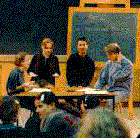


|
Resolving Conflict Creatively.
Negotiation Subject Headings:
Grades 7 - 12 / Ages 12 - 17. *** /4
|

The two video tapes in the series Resolving Conflict Creatively deal with negotiation and conflict mediation skills.
The first video in this series, Negotiation, uses realistic dramas which are entertaining and, at the same time, provide concrete examples of conflict. A teacher presents the lesson on negotiation skills in a clear and knowledgeable fashion by using audience role playing, charts, drama, and lectures. As well, the presenter notes the difficulty of two people using negotiation skills when there is a power imbalance or violence involved. By bringing up this point, a smooth transition is made to the second video, which focuses on third party intervention or "mediation."
In the second video, Conflict Mediation, the same presenter does an excellent job of connecting the two videos by presenting a short summary review of negotiation skills. Again, the dramas are realistic and entertaining. I like the way various conflicts are illustrated using family, peer, and student/teacher scenarios. Generally the mediators do a very good job of illustrating the mediation process. Mediation is broken down into four phases in this video which helps summarize the process: opening, exchange, resolution, and agreement. In my training of student mediators, the mediation process is divided as follows: introduction and ground rules; story telling; solutions; future solutions; concluding remarks; and agreement.
I noted some differences between the second video and my own mediation training. For instance, the positioning of disputants and mediators is different. In the video, the persons in conflict face each other during the mediation. In our program, our student mediators are taught to position the disputant's chairs so they are facing the student mediators at a forty-five degree angle. In the early stages of conflict mediation, I have found that having students in conflict face the mediators rather than each other helps to prevent further conflict being created by hard looks or staring. As well, our mediators use a prevention phase which has the students in conflict plan for the future using more appropriate responses to conflicts.
I recommend these videos as excellent instructional tools in the classroom.
Recommended.
Gary Sova is a Behaviour Support Teacher in the Special Education Department of Winnipeg School Division No 1.

To comment on this title or this review, send mail to cm@umanitoba.ca.
Copyright © 1997 the Manitoba Library Association. Reproduction for personal use is permitted only if this copyright notice is maintained. Any other reproduction is prohibited without permission.
Published by
The Manitoba Library Association
ISSN 1201-9364
AUTHORS |
TITLES |
MEDIA REVIEWS |
BOOKSHELF
BACK ISSUES |
SEARCH |
HOME